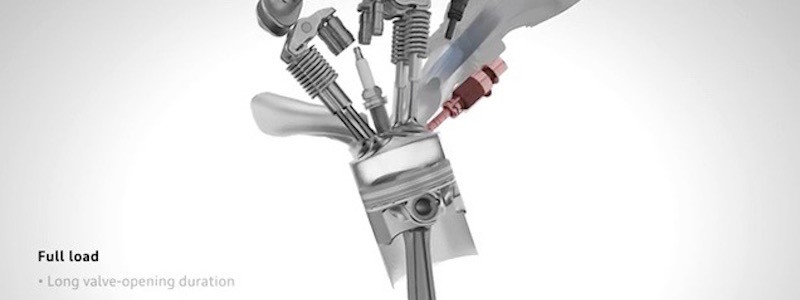The Audi A3 gets a technology update, including a Millerized engine
This spring, Audi will begin shipping the model A3 with a refreshed line-up of engines, including a new 3-cylinder, 1.0L engine and a new 2.0L engine with variable compression ratio to improve efficiency. The new A3 will come in a three-door, sportback, sedan and cabriolet formats. A new driver assistance and virtual cockpit features are also added, but first let’s take a closer look at the new engines.
The new 3-cylinder, 1.0-L engine is compact, reducing the overall mass of the vehicle and thus requiring less energy to move. The power output is 115 hp (85 kW) and 148 lb-ft (200 N·m) of torque in the 2,000 to 3,500 rpm range. There is also a 1.4L engine featuring fuel-saving cylinder-on-demand (COD) operation, in which two of the cylinders effectively turn off when full power is not needed.
Perhaps most interesting is the completely new “Millerized” 2.0L engine. When heavily-loaded, it operates very much like a typical Otto-cycle engine with a high compression ratio of excellent efficiency. But when lightly-loaded, the camshaft that controls the opening and closing of the valves slides into a different position. In this new position, the intake valves close early. This has the effect of shortening the compression stroke relative to the expansion stroke, in terms of relative pressure, which is the key to the Miller cycle’s higher efficiency levels. Watch this video to see the mechanics.
Also incorporated in the new A3 line-up are new, more efficient transmissions (in particular, the 2.0L turbo fuel stratified injection (TSFI) will be joined by a newly developed, seven-speed S tronic with wet clutch, replacing the previous six-speed dual clutch transmission). The A3 will use an advanced, adaptive cruise control system that stops and starts the car automatically in slow-moving, congested conditions. It will even steer itself in speeds up to 65 km/h, provided the road is well-paved.
The highlight in the interior of the new Audi A3 is the Audi virtual cockpit, previously available only in larger models. The most important driving-relevant information is displayed in high resolution on a 12.3-inch diagonal thin-film-transistor (TFT) liquid-crystal display screen. The driver can switch between two views by pressing the “view” button on the multifunction steering wheel. In classic mode, the instruments appear as large as the usual analog displays. It evokes the virtual display Tony Stark uses in his Iron Man suit.
The new Audi A3 Sportback also will come in an e-tron version, which relies on a plug-in hybrid system to boost the power output of the 1.4L TFSI engine from 110 kW to 150 kW. Full charging of the lithium-ion battery (8.8 kWh) from a 380-volt three phase-current supply (this is in Europe) takes a little over two hours.
The Tech-K.O. Takeaway: Each of the engine options uses TFSI. Generally, Millerized engines should deliver a 5 to 7 per cent improvement in thermal efficiency. We’ll have to wait to see what the fuel efficiency ratings will be for these new models. New two-stage connecting rod designs are being examined as an alternative way to deliver the benefits of variable compression ratio, as with a Miller cycle, but at less cost. The technology is simply moving so fast!
The new Audi A3 series goes on sale in early May, with the first deliveries to customers occurring this summer. The basic price for the Audi A3 with the new 1.0 TFSI engine is €23,300 (US$26,550) in Germany.
- Full story at Green Car Congress.
- Source: Audi. “Technology Update for the Compact Bestseller – the new Audi A3.” Audi-mediacenter.com, 6 April 2016.
- Photo: Frame from animation of Audi’s Millerized 2.0L TFSI (Audi AG via Mike Millikin).

